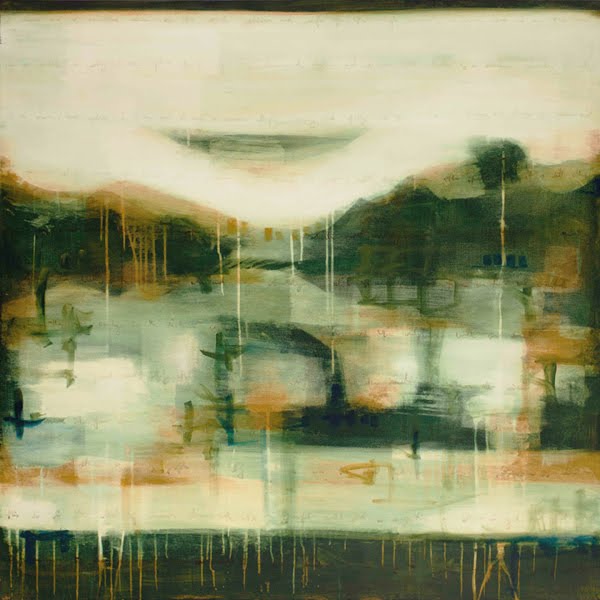Julie B. Montgomery pursues a vision of painting that combines a zen-like appreciation for
the value of spontaneity with a meticulously planned process. Blending
rigor and freedom in this way allows her to create convincing landscapes
that retain the compositional integrity and shifting layers of color
one ordinarily associates with pure abstraction.
To visit Montgomery, a group of us took Amtrak's Surfliner from the station on State Street in Santa Barbara to Carpinteria, a journey of approximately ten minutes duration. From the Carpinteria station, it was an easy walk alongside the tracks that led us to the former loading dock that serves as her front porch. Following the way pointed out by a small sign that says "Entrée des artistes," we encountered a long room dominated by large canvases, sketchbooks, and natural light.
Montgomery paints in acrylic, and she begins by layering all the paint she plans to use directly onto the canvas. Once this "block" of pigment has been mixed and spread, she has a limited period of time in which to carve into it with palette knives, spread it again with large brushes, and finally scrub parts of the surface with rags containing small amounts of a secret miracle solvent that turns out to be 409. When I asked Montgomery to explain the logic behind this somewhat unorthodox procedure, she said, "I started working this way for practical reasons. I moved from using Conté on paper to painting in acrylic on canvas because that process worked better for me. But I've also always been interested in sculpture, and that's part of it as well. By mixing the paint on the canvas and then drawing on that surface by scraping, I was able to get the reduction effect that I had seen in the foundry. The chemistry of it is unpredictable, which is part of what makes it interesting."
 |
| Mariposa Green 54" x 120 |
Within the first hour or so, these acrylic pigments begin to harden,
so it is very important that Montgomery know where she is going when she
sets out. Leafing through her many sketchbooks, one sees an artist's
hand in evidence that is meticulous, line-oriented, and seemingly quite
far from what's on the walls. I asked her about this, and then about
what gives her the ability to work with such an unstable,
abstract-seeming arrangement and still end up with recognizable
landscape images. "I feel so close to my subject matter with these
paintings that it seems to pass through me onto the canvas," she says.
"The drawings in my sketchbooks are more archetypal figures, but the
canvas gave me different constraints to work with and against, like the
sense of a band at the top and the bottom of the picture. That cued my
response, which was to draw landscapes."
Digging a little deeper as I studied the grid-like structures in her "Mars" series of paintings, I asked Montgomery to say more about the idea that she is doing "action painting." She said that she does "work on the composition first, but once I've set up the canvas and applied the pigment, it becomes a drawing exercise in which I am working against the clock. I have to be quite deliberate with my decisions at that point because within an hour or so the paint will set. I work fast, and although I have still got the urge to do very exact stuff, something that you can see from my sketchbooks, when I am painting in this way there's a feeling of spontaneity that's important as well. I find the intensity of the emotion is there in the urgency of the act."
 |
| Mars II 48"x 48" |
"I feel a strong connection to the environment and I think my work
reflects that. The way I work feels like skating to me, or running
downhill. It's one of those activities where you throw yourself forward
with a kind of deep inner trust. I think in part my fascination with
layers of color began when I spent lots of time going to the museum in
order to look at Mark Rothko's work in person."
 |
| Mars III 48" x 72" |
About the Author
Charles Donelan has lived in Santa Barbara since 2001. He writes
about visual art, music, theater, and books for the Santa Barbara
Independent, where he is the arts editor.





by Charles Donelan